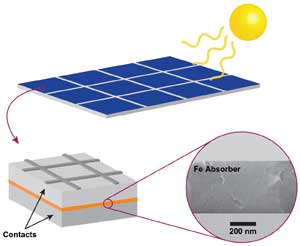Fool’s gold may not live up to its name after all. Iron pyrite – aka iron sulfide – has been mistakenly overlooked as an efficient solar cell material for too long, according to researchers at Oregon State University in Corvallis, who took a closer look at its properties and uncovered a promising alternative to today’s thin-film materials.
Today’s thin-film solar cells are dominated by copper indium gallium selenide and cadmium telluride, which demonstrate efficiencies greater than 10 percent. But because the toxicity of cadmium and the scarcity of indium pose a threat to these technologies, viable alternatives are necessary for high-efficiency thin-film solar cells to continue to develop.
Iron pyrite has some winning attributes when it comes to photovoltaic (PV) applications: An excellent absorber of solar energy, it contains two of the most abundant and least expensive elements to extract from the earth, and it can be made into layers 2000 times thinner than some of its competitors, including silicon.
The stumbling block? Converting the solar energy into electricity. Although using thin layers lends itself well to efficient light absorption, scientists have found that the promising material iron pyrite simply does not work in PV systems.
Professor Douglas A. Keszler and colleagues from the university’s chemistry department decided to find out why.
It turns out that, in the process of creating solar cells, which takes a substantial amount of heat, pyrite decomposes and forms products that prevent the creation of electricity.
Armed with that knowledge, the group sought to find the best of both worlds – combining the desirable capabilities of pyrite with the stability offered by traditional thin-film materials.
The result was iron silicon sulfide (Fe2SiS4) and iron germanium sulfide (Fe2GeS4).

This iron germanium sulfide thin-film solar absorber could be a promising new technology for solar energy. Courtesy of Betterton Design.
“We identified the failure mechanism of pyrite, formulated a few design rules that preserved the favorable aspects of pyrite, and identified Fe2SiS4 and Fe2GeS4 as new absorber candidates,” Keszler said.
This relatively new approach to materials science is known as inverse design.
“As experimentalists, we work very closely with theory groups at the National Renewable Energy Lab [in Golden] and the University of Colorado to first extract design rules from a combination of high-level calculations and chemical principles,” Keszler said. “We then go to the lab to make new materials and examine their physical properties.”
Iron, silicon and sulphur are among the three most available and low-cost elements on Earth, and, thanks to their high absorption coefficients, much less of the material is required. This means that they can be used in thin-film devices, which can be fabricated at low cost.
The results of the study were published Aug. 10, 2011, in the online edition of Advanced Energy Materials.
But despite the many promising findings, Keszler and his colleagues are not fooled – they acknowledge that much work remains to be done. In fact, Keszler said, a marketable alternative to traditional solar cell materials is still about 10 years off.
“The quality of Fe2SiS4 and Fe2GeS4 needs to continue to improve so that fundamental, intrinsic performance can be established,” he said. “Appropriate contacts need to be developed, and integration issues with respect to cell fabrication need to be addressed.”
The group is working on advancing thin-film quality so the properties and performance of the materials can be benchmarked against theoretical predictions. They also are looking to refine design rules so that other materials with promise for higher performance in solar cells can be identified.